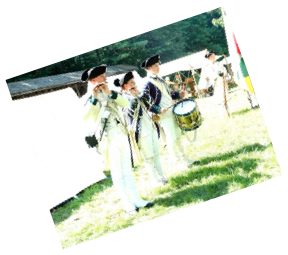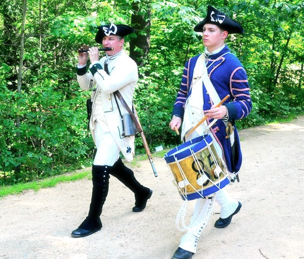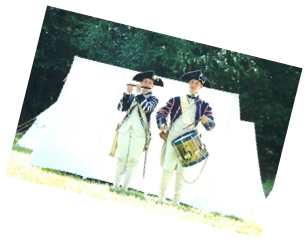


As in all armies of the late 18th century, the evolutions of the camp were controlled by the music and signals of the fife and drum. With no field radio or broadcast system available in this time, daily camp functions, ceremonies, marching and field maneuvers were announced by particular musical signals played by the one fifer and drummer assigned to each company of approximately 30-40 men. For instance, the musicians told the soldiers through their signals when it was time to get up and start the workday, when to pack up camp and march, when to fall out for assembly, when to go to church, when to gather to get food, when to form work details, how fast to march, when to retreat, when to charge bayonets, when to offer salutes to VIP’s or colours, when the workday was finished, and when to retire to the tents for the night.
With these important tasks to accomplish, it was vital to be heard across the camp and above the din of battle. The French army used some of the most advanced instruments of its time. The French fife is a transverse flute with no keys and six finger holes. The French played a smaller fife than their British or American counterparts, sounding near the key of D – a higher, more easily heard pitch than the more common British fifes using the key of C. The French drums of this period had shells made of brass, were tensioned with rope and had snares on the bottom head to raise the frequency of the sound. This combination produces a brighter, louder sound compared to the wooden drums of the British and Americans.
While a musician would carry a sword to ward off personal attacks, he would have no gun, and was therefore a non-combatant in a battle situation. His uniform was distinctly marked so that he could be easily seen on the battlefield as a non-combatant to the enemy and as a signaller to his own officer. All French musicians were dressed in blue coats trimmed in the regimental colors and distinctions as the regulations warranted. They also had coats heavily trimmed in lace to further their distinctive appearance. Fifers wore silver lace. Drummers, technically provided to the privately owned regiments by the King, wore the red and white chain-patterned lace of the King, called the Livery du Roi.
The colonel of the regiment often maintained a “Band of Musick” which was a small woodwind and brass chamber ensemble. This band did not seem to have any administrative function, but was strictly an entertainment group in camp and on the march to advertise the “grandness” of the regiment at parties or on parade and to keep up the pride and morale of the regiment. They were an important ice breaker between the army and the local townspeople as they would perform for local dances and concerts.